*This is a feature article I wrote about the long and complex history of SFU’s Burnaby campus being used by Hollywood for shooting movie and TV shows. It was a very thorough investigative follow-up to an article I had written about a year earlier about Seth Rogen’s confrontation with the school over a request to use the campus for his movie The Interview. The article is the result of over a dozen original interviews and untold hours of archival research. It was originally published in the spring issue of The Tartan.*
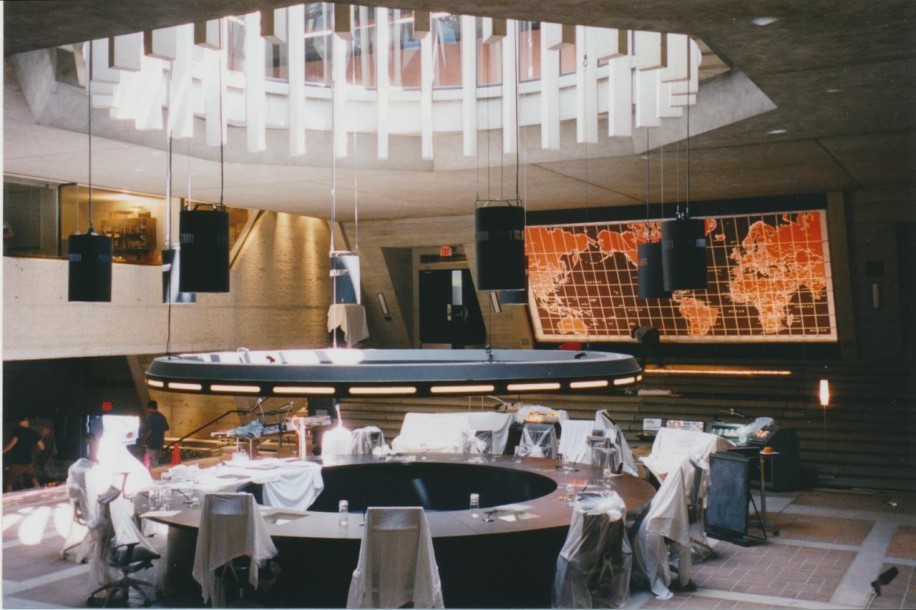
Image Credits: Caryn Cameron
It’s been a top secret government laboratory, an evil corporation, NASA, the headquarters of the CIA and the FBI, a military academy, a military academy in space, the planet Caprica and a portal from a Stargate to another universe.
It’s where Keanu Reeves was interrogated about an Alien invasion, where Ryan Phillippe cracked a worldwide computer conspiracy, and where a hockey-playing chimpanzee once mopped floors on rollerskates. It’s been dressed up, dressed down, and exploded into a million pieces.
While you may know SFU’s Burnaby campus simply as a place you take classes, it also leads a secret double life — it’s a bonafide movie star.
From its first starring role in the early 70s to its boom in the 2000s, the film industry has a deep love for Arthur Erickson’s famed brutalist tribute to Greek architecture.
But that love is not always requited.
Since the first film crew travelled up Burnaby Mountain more than 40 years ago, there has been a certain amount of tension between the university as a learning institution and as a filming location. Once very accommodating to filming, SFU has become increasingly reluctant to dedicate energy into being a location site for feature films and TV shows.
Neither the local film community nor the university have any resentment towards one another, however there is obvious frustration on both sides.
While SFU will probably always be Vancouver’s go-to ‘vaguely evil looking location’, its long and complex history with filming make it difficult to predict whether it will continue to be a major player in the film location game – or if it even wants to be.

When SFU opened in 1965, it didn’t just give British Columbia a new post-secondary education option — it gave the world a new architectural masterpiece to marvel at.
Inspired by the Acropolis in Athens, architects Arthur Erickson and Geoffrey Massey gifted Vancouver with a look that did not previously exist anywhere nearby. It was big, futuristic and powerful. The public instantly fell in love with it, and so did the camera.
The first people to set movies on top of the hill were undoubtedly the early ‘students’ at the SFU Film Workshop, a part of SFU’s Centre for Communications and Arts — a non-credit fine arts program which existed in SFU’s early days — but it was Hollywood that gave SFU its first big break in the early 1970s.
Although the first movie to make a deal with SFU was an adaptation of Aldous Huxley’s Brave New World, which had an agreement in principle to shoot in 1971, the deal fell through and a less acclaimed sci-fi film entitled The Groundstar Conspiracy took its place.
Nini Baird, the director of the Centre for Communications and Arts, who was responsible for the production coming to campus, remembered not having any procedures in place for filming at the time.
“There weren’t any guidelines, we were making it up as we went along,” Baird explained about her involvement in the movie. “They filmed 24/7 . . . for three weeks.”
Groundstar’s production designer, Cameron Porteous, remembers SFU as being an “absolutely perfect” location for the movie and they took full advantage of a large portion of the campus.
“We did quite a bit at SFU. The university was designed to be some sort of great centre for investigation, similar to the CIA,” Porteous recalled.
According to Porteous, there were no problems with filming on campus and as they shot during the summer, there was little disruption to students and almost no fanfare. There was one visitor who did capture his attention however.
“I remember one day Arthur Erickson came to the university and I was introduced to him and I sort of was embarrassed a bit because I had, in a sense, doctored up his architectural dream,” Porteous recalled saying he had just built an observation centre on top of the mall roof for the movie. He needn’t have worried though because “[Erikson] said, ‘No, no … the whole idea behind architectural structures is they must adapt to the needs of the people and it’s adapting beautifully to your needs and that’s all that matters.’”
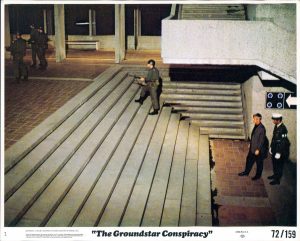
On May 11, 1972, The Groundstar Conspiracy held its world premiere at the Vogue Theatre with proceeds going to fund an SFU student aid bursary. Although, in their coverage of the event The Peak gave the film the less than flattering review of a “two-star television movie,” SFU’s film location experiment was an overall success and SFU was now open for “film” business. It would take a while to heat up though.
While there certainly was some student filming done at SFU in the years following 1972, there wasn’t another major Hollywood production on campus until the late 1980s.
On December 17, 1985, SFU instituted a policy for ‘Visiting Film Companies’ that states that “in support of B.C.’s film industry, [SFU] is prepared to permit the use of its facilities by film companies for productions which do not detract from the image of the University.” Aside from a revision in 1993, this policy remains intact to this day, along with the “charge of $2,500 per day for each day the film company is on campus.”
While the policy also suggests that “the Vice-President, Finance & Administration is responsible for protecting the interests of the University, negotiating agreements, and making appropriate arrangements,” this responsibility was delegated to the Facilities Service department, which the VP oversees.
Although the reason for instituting this policy at that exact time is unclear, it seems to be due to both a sudden massive rise in filming in Vancouver in the mid-eighties and potentially the aftermath of some sort of unfortunate filming event at SFU.
While the specifics aren’t clear, in a 2015 interview with The Peak, SFU Facilities Services Supervisor of Client Services, John Briggs – the man who deals with all filming on campus today – mentioned that a reason SFU has the policy in place, is that there “have been pornography movies made [at SFU . . . that] weren’t intended to be, as far as we knew.”
Location manager, Ann Goobie, confirmed this story, as a legend at least, telling The Tartan that “some of [SFU’s paranoia] about being seen in the wrong light is based on some movie from the 70s that filmed up there. They thought it was Buck Rogers or something, and it was some porno film,” though she clarifies that she didn’t know the specific truth behind the incident.
Either way, in 1988, the film The Fly II chose SFU as one of their major locations and became the first production to deal with SFU’s new official policy.
As a new responsibility for Facilities Services, the job of handling incoming film companies was given to a 25-year old building technologist in his second year with SFU named James Atamanchuk. The responsibility ended up suiting him perfectly.
“I wasn’t like anybody else in the office so they thought I was a perfect personality to throw [filming] at,” Atamanchuk explained. “It was just something that happened once and then that was it.”
The experience of shooting The Fly II in 1988 was described as quite pleasant by the film’s assistant location manager, John Penhall, who remembered how great dealing with Atamanchuk was.
“He was wonderful [and] he knew the buildings really well,” Penhall remembered. “He walked me around and showed me the stuff that was really cool about SFU.”
Penhall said that SFU, through Atamanchuk, was very accommodating to the production despite having their natural concerns about not disrupting classes or causing damage. While Penhall said that he didn’t work on a film at SFU again, he loved the experience and recommended it to many directors during his 10 year career as a location manager. He did admit, however, that it does get a bit typecast.
“SFU always plays the evil corporation. And it does have that kind of look [. . .] that’s what we were going for in The Fly II,” he explained. “[It’s always] used for films like that where it’s supposed to be an impersonal, industrial campus.”
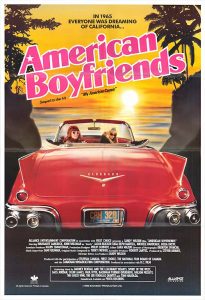
The second movie shot at SFU however was the one movie that broke the mould and played just a normal university, a place called Simon Fraser University.
Almost 20 years after graduating, SFU Film Workshop alumna, Sandy Wilson, returned in 1988 to film scenes for a sequel to her hit movie My American Cousin — which won six Genie Awards for excellence in Canadian film — entitled American Boyfriends.
Wilson’s recollection is that they were only on campus for a few days and had no problem securing SFU as a location. “[We had] a lot of trouble with almost every other location,” Wilson recalled. “We did some shooting at the Waldorf, that was a nightmare. We did some shooting down in the United States and that was a triple nightmare! But the SFU part was kind of fun.”
Throughout the 90s, SFU became a fixture for filming in Vancouver,
especially for TV shows. The campus appeared in shows like Viper, Sliders, Stargate SG-1 and the X-Files, and also briefly in the TV-movie I Still Dream of Jeannie and the family comedy film MVP: Most Valuable Primate.
For the most part, SFU and visiting film crews got along quite well. Atamanchuk remembers fielding hundreds of requests throughout the 1990s, with around two or three shoots actually taking place every other month. However, at the turn of the century, one production caused SFU to rethink its role as a filming location.
After a decade of almost exclusively filming television at SFU, at the end of 1999, SFU was turned into a major motion picture movie set when the Arnold Schwarzenegger movie The 6th Day requested the campus’ services for a major car chase scene.
For those working on the movie, filming at SFU was a great situation. As Paul Lougheed, an assistant location manager for the film’s first unit, who were only up at SFU for about a night, said “We were up there with Arny [and] we had a helluva good time out there.”
From SFU’s side however, it wasn’t all fantastic. The film was a much larger production than anticipated. While it was initially estimated that filming would take about 10 days on campus, the second unit ended up being at SFU for more than a month, completing set-up and stunts for what ended up being a two minute scene in the movie.
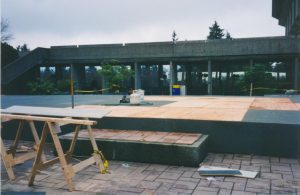
They also needed to make significant alterations to campus to make a car chase through the Academic Quadrangle and the mall possible. According to an SFU News article from February 10, 2000 entitled “Arny’s Army Invades Campus,” several “highly visible changes to the campus” were required. This included “the draining of the AQ pond so a new bridge could be built, the removal of several stairs leading to convocation mall so a more shallow set could be constructed, and the appearance of banks of lights and other equipment across campus,” all of which were completed by film crews over an extended period of time.
The major problems occurred during The Sixth Day’s third and final visit to campus in January 2000 when the second-unit was filming stunts. The problems were accelerated due to a CUPE strike that caused Atamanchuk to be temporarily unable to act as SFU’s liaison for filming.
“Somebody else took over […] management, and they’re not familiar with film companies. Unfortunately, it was very bad timing for everything,” Atamanchuk recalled. “It was too big for the campus and the amount of damage that had occurred to heritage architecture and stuff [was unfortunate].”
The difficulties of housing such a major film were further brought to light by an incident that occurred on January 31, 2000 covered by The Peak, in which some fumes caused by the production found their way into the library and caused an early closure after some students reporting feeling ill. Although SFU was reimbursed for everything, it caused a lot of trouble for the university.
“People got really pissed off. They went up to the VP. It actually went to the board of governors. So it was very bad,” Atamanchuk recalled. “So filming was ceased, for a short period thereafter.”
Comments made by associate VP-administration Rick Johnson indicate that the university was not happy with the general condition of cleanliness of the production and it caused serious doubts about allowing filming in the future.
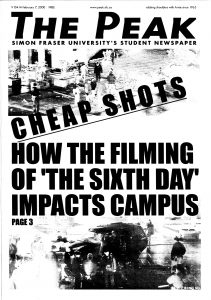
“After this particular film, we’ll be assessing whether we’ll do anything of this nature again,” Johnson was quoted as saying at the time, and explained that “most films are restricted to localized areas on campus, and don’t have the broad impact that this one has had. Filming of this scope has presented many challenges in terms of our ability to coordinate it.”
Despite the difficulties however, SFU was rewarded handsomely, receiving approximately $150,000 in site charges and recovery costs. From 1991 to 2000, the university collected nearly half a million dollars with almost half of that — $225,000 — coming from 1999-2000 alone. And while a review of their filming practices was held afterwards, it didn’t stop being a site for major films. However, in The 6th Dayaftermath, SFU gained a reputation of being a difficult place to film, a feeling that permeates to this day.
Despite the massive hassle that The 6th Day caused for administration and students alike, the affair did not cause any significant changes in SFU’s filming policies. The pleasant, agreeable situation described by location managers before the year 2000 has since been replaced by a less straightforward or compromising system.
While Atamanchuk said no major official changes were made, after 2000 there were more people involved in making filming happen. “I was more managed. There were more people watching,” he explained.
Bruce Brownstein, who worked as the location manager on both Antitrust (2001) and Agent Cody Banks (2003) — the next two major shoots on campus — described the experience of securing the SFU locations for those films as “very difficult, expensive and time-consuming compared to filming at UBC for example.”
Brownstein believed that following the problems with The 6th Day, filming at SFU began to be “always very difficult and extremely bureaucratic,” and even recalled having to go up and beg to allow Antitrust to film on campus.
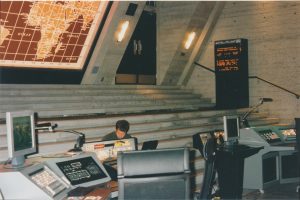
“The Location License Agreement was another thing that went back and forth forever,” Brownstein explained, recalling his first experience with the university. “Once one production jumped through the myriad of hoops, it confirmed that [SFU] felt they were on the right track to protect the campus and weed out frivolous productions.”
Ann Goobie, the location manager for the 2008 film The Day the Earth Stood Still, who did extensive filming at SFU, had similar feelings about doing work at the university, and said that it is the location license agreement that is the major problem.
“It’s not the easiest place to film sometimes,” Goobie, who graduated with a degree in Communications from SFU in 1989, explained. “[There is] this clause that they have in the contract […] it gives [SFU] the right to enjoin the movie — to stop the movie from being distributed — if there is something in the movie that they feel is showing the university in a bad light.”
According to Goobie, this ‘enjoinment’ clause has caused problems for almost every production that comes up to film at SFU, and it often causes larger movies to move their filming elsewhere. “They can’t put their product in jeopardy because of one entity.”
This situation occurred most recently — to the knowledge of the public — with the Seth Rogen movie The Interview, which wanted SFU to pose as North Korea for some scenes in the summer of 2013. After a long dispute of trying to make changes to the agreement, and having SFU refuse, they begrudgingly chose not to film on campus.
In an article published in The Peak in February 2015 concerning The Interview situation, the SFU representative John Briggs claimed that it is SFU policy to not change the agreement, and that he made that very clear to Rogen’s team from the beginning. He also said that he couldn’t even remember the “minor, insignificant things” that they requested be changed.
According to Goobie, however, the problems with the location agreement are not minor, and while SFU is reluctant, they have made amendments to it before.
“I’ve gotten that changed in the past, with quite a fight going on to get it done mainly with the guys on the Burnaby Campus rather than the guys downtown,” Goobie recalled. “I had the film commission and a VP from the downtown campus help me. And, I don’t know who he called, but they basically said, ‘you make this change’ and we paid to make the amendment and we got the change.”
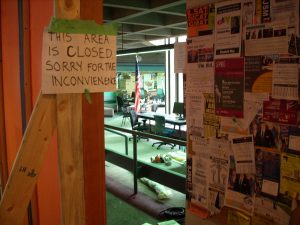
Goobie says that she has often received phone calls from other location managers requesting the amendment she received, and that the location manager of The Interview even suggested that their production was facing the exact same problem that hers had more than five years prior. She claims that SFU should be well aware of the problems with the agreement by now.
“The film commission has been through it. They’ve gone up there a gazillion times to sit and talk with them about this stuff,” Goobie explained. “It’s just really gotten nowhere and there’s no rhyme or reason why, quite frankly. You know it’s easily resolved with different language in a contract.”
In his interview in The Peak in February, Briggs took the complete opposite stance however, stating that very few productions had any problem with the agreement and that the occasional large production that did have a problem wanted no more than to “change the sentence or the wording of a sentence sometimes, just to suit themselves.”
While Briggs’ opinion seems reasonable, it runs into problems when you consider that what he describes as a waste of time is exactly the procedure at UBC, the school that SFU initially modeled their procedure and rates after. There is no standard contract at UBC, which allows minor changes to be made when it seems reasonable to do so.
The large disconnect between BC’s two biggest schools has major implications for SFU’s confrontational reputation in the film community. Many complaints from location managers aren’t necessarily focused on how SFU is difficult, but how easy UBC is to deal with in comparison.
At UBC, filming is being done constantly with an average of over 40 productions shooting on campus per year over the last seven years. While they charge the same daily rate as SFU, UBC has invested more into making it a regular activity, perhaps seeing it as a good source of revenue.
Greg Jackson, whose only experience at SFU was back in 1991 as an Assistant Location Manager for the TV movie I Still Dream of Jeannie, but who has been part of the film community for over three decades, explained that for one reason or another UBC has made it their business to be a filming location and SFU hasn’t.
“[UBC] is extremely film friendly and has a very smooth process for scouting and choosing locations,” Jackson explained, saying that unlike SFU, UBC has a dedicated person who deals only with filming. “SFU, up on the hill, for whatever their internal reasons are, they don’t look at it that way.”
According to Goobie, having that one person dedicated to filming at UBC makes it run smoother than at SFU, where a representative from Facilities Services — who has a lot of other responsibilities — is in charge. She explained that this allows UBC to read every script they get and properly protect themselves against any damage to their reputation.
“SFU is not interested in reading the script. They want you to provide just a little synopsis,” she explained. “It’s an easy thing to change in their contract that would still cover them off for inflammatory stuff, and fair enough, but anyway, it’s not a priority.”
It frustrates me because you know I’m an alumnus, but that’s their process.”
Once again however, while Atamanchuk only commented on the way things were between 1987 and 2007, he said that while UBC and SFU are both universities in BC, they share nothing else in common when it comes to being a filming location.
“We are completely different campuses, completely different everything. The Burnaby campus is quite compact overall whereas UBC is quite spread out,” Atamanchuk explained. “[At UBC] they could be filming in one corner and nobody would ever know. They’re independent buildings, they’re all separate. SFU’s quite connected.”
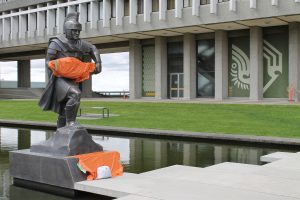
Despite the complaints from location managers about some of the difficulties they’ve had with SFU, they all admit there are still some positive aspects about shooting at SFU and do appreciate what the university has been able to do for them, to an extent.
“It all worked [and] once we got in there for The Day the Earth Stood Still it was really quite good,” Ann Goobie said, explaining that she just wished the process could be a bit smoother.
David Brisbin, who worked as the production designer for The Day the Earth Stood Still, was especially appreciative to have gotten the chance to showcase SFU.
“I’m incredibly grateful when people who have [interesting spaces and extraordinary architecture] are willing to try and bend and twist a little to allow those of us who make films to make use of it, because it’s a way of allowing that architecture to resonate through media culture,” he explained, mentioning that he had also met Arthur Erickson before he passed away and was honoured to show SFU to the world. “I think it’s great for his good work to be propagated a little bit further, even beyond what’s propagated among the students who use it.”
Although SFU’s relationship with filming is definitely not simple, despite the tension on both sides, ‘SFU: the film location’ is by no means dead. Just last year, the TV series iZombie filmed in the hallway of Saywell Hall, and the Surrey and Downtown campuses have begun to accommodate a number of productions every year, with location managers seemingly universally positive about their experiences there.
Already this year, according to Facilities Services, as of November, the university has received $4,103 for filming in 2015-16 and in the last two years pulled in $11,738 and $30,972 respectively. While it is not the whopping $220,000 they got in 1999-2000, or the $327,036 they earned in 2010-11 when Underworld Awakening was filmed, it does meet the $20,000 average they were earning for the nine years prior to that.
The situation could be better, however. According to Facility Services statistics, although SFU does not keep a log of how many requests for filming they receive per year, they estimate about 20 to 25 per year and accommodate one or two. With a set fee of $2,500 a day, a deposit of $5,000, and a number of other charges, SFU could be making plenty more for their general revenue if they accepted more offers and had the frequency of filming that UBC does, which allows on average 50 productions to film each year.
At the very least, a dedicated SFU filming person or department could make filming revenue consistent instead of changing drastically from year to year, as was the case between 2010-11 and 2011-12 where filming revenues went from over $300K to a total of $424 respectively.
While SFU, rightly, puts education first and sees their role as a film location as a favour to the film industry more than anything, having a single dedicated person in charge of filming at SFU and a little more flexibility to amend their Location Licence Agreement could go a long way in repairing their relationship with location managers and film studios, and earn some money for the school.
Hollywood may always cast SFU as the villain — the ominous, scary building on a hill — but it doesn’t need to be that way off camera too.
